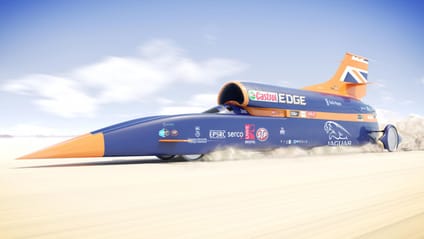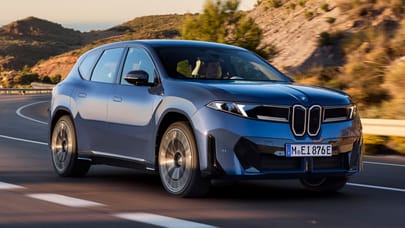
Here's why the Bloodhound land speed project is amazing
Bloodhound runs into trouble: here are the numbers and reasons why it needs saving


Earlier this week, the Bloodhound SSC project to break the Land Speed Record went into administration. It’s not the end of the road – as you can read here, the team is hoping to find a major investor to put up to £25 million into the project, the goal being to take the Land Speed Record beyond 1,000mph.
We’ve been following the project since it was first announced almost ten years ago, and our involvement has included not only getting to know the team, but, slightly unbelieveably, helping to build the car, visiting Hakskeen Pan in South Africa, trying to understand the engineering and so on. We don’t just think Bloodhound is cool, we think it’s important. Here’s why.
Advertisement - Page continues belowBecause the numbers are ridiculous

All of the numbers. Not just the 1.5g acceleration, or the 120,000bhp total power output. Personal favourite? The rocket is a hybrid which means it uses both solid and liquid fuels. The solid is rubber and already in the rocket, the liquid is HTP (High Test Peroxide) that needs to be pumped into the rocket very fast. Which requires a big pump. Initial plans had a Cosworth Formula One engine performing this role. Then a supercharged Jaguar V8. Now most likely it’ll be an electric motor. The parameters haven’t changed though – it’ll need to pump 800 litres of fuel into the rocket in 17 seconds. At that rate you’d fill your car in a second. Oh, and at 1,000mph, Bloodhound outruns the bullet from a magnum .357. It’ll also have set an airspeed record for low flying aircraft...
It uses rockets!

And not just any rocket engine but the Nammo Nucleus, which was recently successfully tested and will also be used by the European Space Agency. In testing last month it reached 107.4km of altitude in three minutes. Should be just the ticket for giving an eight tonne record car a healthy extra shove when it’s lit at 300mph.
Advertisement - Page continues belowIt’s actually moved under its own steam already

This time last year Bloodhound ran in anger for the first time at Newquay Airport in Cornwall. In fact it ran like a dream with no hiccups at all, the only difficulty the response of the Rolls-Royce EJ200 jet engine. After throttling back, fuel is still injected for a second or two, so even when backing off at 120mph, Bloodhound was still cresting 200mph before it began to slow.
And it really wasn’t slow

When the Bloodhound designers and engineers first did the computer predictions for how fast Bloodhound would accelerate, they thought the 7,750kg machine would take around 15secs to reach 100mph. About hot hatch speed. This was because it was impossible to model how soon the EJ200 jet engine would be able to ingest enough air to run the afterburner, the intake having been optimised for 800mph. At Newquay they had the opportunity to find out for real – and the results were astonishing. From a standing start, Bloodhound SSC hit 60mph in 3.50secs, 100mph in 4.73secs and 150mph in 6.3secs and 200mph in 7.62secs. It was piling on 30mph every second, pulling a near constant 5g of acceleration. It’s not a land speed car so much as a dragster. And the team believe it’ll maintain close to that level of thrust all the way to 1000mph.
The cockpit protection was ballistics tested

Driver Andy Green sits deep within a carbon fibre tub of great thickness and strength. However if a stone should be flicked up by one the wheels that wouldn’t be enough to stop it, as it would likely be travelling faster than a bullet. So flanking the tub is a Kevlar ballistics shield panel. These had to be tested. A 9mm bullet didn’t make a dent. Even a rocket-propelled weighted dart didn’t make it through. We’d assume this made Andy Green feel quite a bit safer. Not that a man prepared to drive at 1,000mph is the sort to get put off by stone chips.
Because it’s about getting kids excited about science

A key part of Bloodhound’s remit was the knock-on effects of breaking the Land Speed Record, specifically getting kids excited about pursuing careers in STEM (science, technology, engineering and maths). So far the outreach campaign which has included Bloodhound ambassadors visiting schools, running projects to build and race small rocket cars and visit Bloodhound headquarters in Bristol, has reached over two million school children.
Advertisement - Page continues belowBecause we built it

This probably isn’t what any potential investors wants to discover, but yes, Charlie Turner and I spent a day building Bloodhound. This was in the key construction phase and when we arrived at their Bristol premises Charlie was given an orbital sander so he could polish the titanium upper bodywork, while I was allowed to help attach some of the 192 pressure sensors sited around the car, attach several of the 12,000 rivets that hold it together and use an endoscope to check everything was aligned properly.
And delivered bits of it

Back in 2013 we were tasked with delivering the very first aluminium wheel block from the Fuchs foundry in Germany, to Castle Engineering in Glasgow. Here, the 220kg cheese wheel would be machined into something able to cope with the rotating forces at 10,200rpm and tolerating 50,000g at the rim. The fact Bloodhound isn’t short one wheel means we didn’t fail.
Advertisement - Page continues belowBecause the track is ready and waiting

Hakskeen Pan is in the Northern Cape of South Africa. The Bloodhound team identified it years ago as the ideal place for record runs due to its hard, level surface. Just one problem: it was covered in stones. 300 people were recruited locally and they spent three years clearing it of debris – a 20km length of the Pan 1500 metres wide. It’s there, it’s ready, we’ve been, and they’ve even tested communications equipment so they can get live feeds from the car and broadcast them around the world live. Imagine: when Andy Green does finally hit the throttle, you’ll be able to watch live onboard footage as he aims for 1000mph.
Because Britain has a proud history of record breaking

OK, the Europeans made the early running, the French and Belgians mostly swapping the record between them up until 1909. But from there until 1947 it was pretty much an all-British affair with such legends as Malcolm Campbell, George Eyston and John Cobb taking the record from 120mph up to almost 400mph – even if they had to go to America to do so. Going to America provoked the locals, who found they had a lot of war surplus jet engines and spent the next 35 years putting them to good use with one man, Craig Breedlove, taking the record through 400, 500 and 600mph. But since 1983 the record has been in British hands, and we took it through the sound barrier, Thrust SSC hitting 763mph in 1997. The same key players, Andy Green, Richard Noble and aerodynamicist Ron Ayers, are at work on Bloodhound SSC. All they need is the opportunity to put the record beyond reach.
Trending this week
- Car Review
BMW 1 Series







